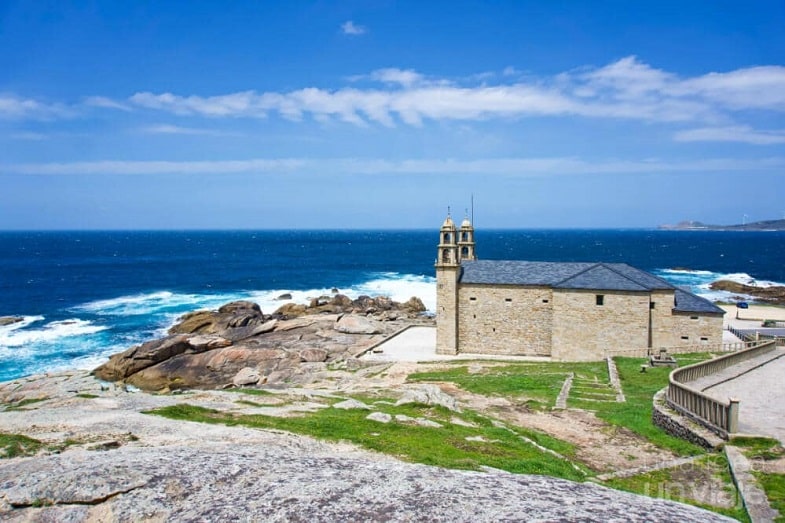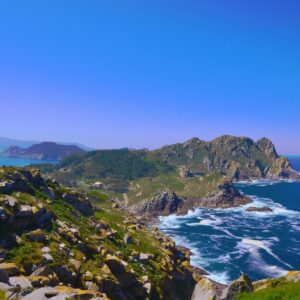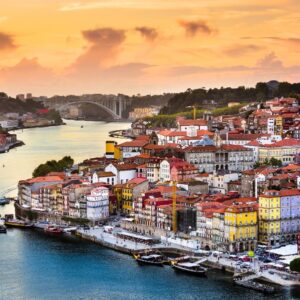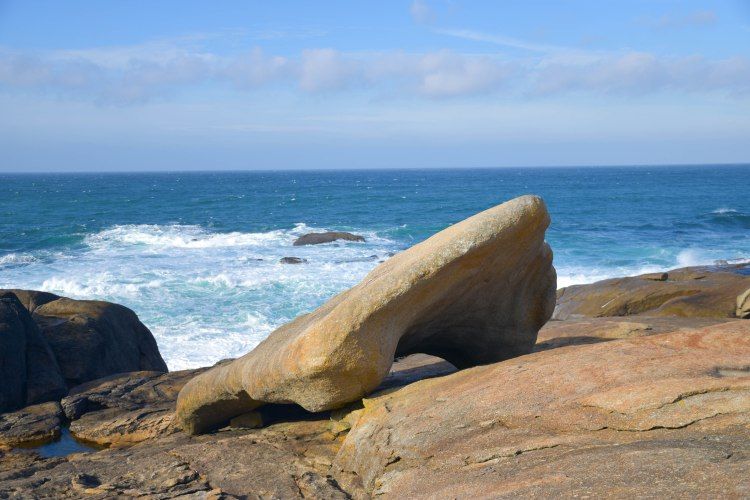MUXÍA: THE CAPITAL OF THE DEATH COAST

Table of Contents
MUXÍA AND THE DEATH COAST
Muxía is a small fishing town located in the province of La Coruña, in Galicia, Spain. It is located in the very famous Costa de la Muerte, an area of the Galician coast known for its spectacular landscapes and its history rich in legends and traditions, in addition to being considered a place famous for its shipwrecks over the centuries.
One of the most emblematic places in Muxía is the sanctuary of Santa María de la Barca, which is located on a large granite slab next to the ocean and from which it dominates the coastline. This sanctuary is an important pilgrimage site for walkers who travel the Camino de Santiago, since it is located on the route that leads to Finisterre, the ancient end of the world of the classical age.
Galicia Travels products
-

Rias Baixas Excursion
Rated 4.93 out of 530,00€ – 55,00€Price range: 30,00€ through 55,00€ Select date(s) This product has multiple variants. The options may be chosen on the product page -

Porto
Rated 4.71 out of 560,00€ – 120,00€Price range: 60,00€ through 120,00€ Select options This product has multiple variants. The options may be chosen on the product page -

French Way
360,00€ – 2.150,00€Price range: 360,00€ through 2.150,00€ Select options This product has multiple variants. The options may be chosen on the product page -
Sale!

Finisterre, Muxía, Costa da Morte
Rated 4.94 out of 520,00€ – 49,00€Price range: 20,00€ through 49,00€ Select date(s) This product has multiple variants. The options may be chosen on the product page
The sanctuary at the end of the earth
The sanctuary of Santa María de la Barca is a place of great beauty and symbolism, surrounded by a special atmosphere that can be perceived in every corner. The church was built in the 12th century and it was originally Romanesque in style, with Gothic and Baroque elements later added in space from the 18th century when it was renovated.
Inside is the image of the Virgin of the Barca, who according to tradition, arrived on a stone boat, a miracle that is often linked to the celtic legends that they have those boats as an example of a miracle in their mythology, and that according to tradition they ran aground on the coast when the virgin met the Apostle Santiago.
In the surroundings of the sanctuary of Santa María de la Barca there are the so-called Magic Stones, granite rocks that have strange and curious shapes. These stones are considered sacred by the local people and are said to have healing properties because according to tradition they would be the remains of the Virgin Mary’s stone boat.
Ground zero of the Costa de la Muerte
Muxía is in some way considered ground zero of the Costa de la Muerte, since it is located in a central part of it. The town is known in addition to its history for its beautiful landscapes, for this reason it is a popular tourist destination for pilgrims who make the Santiago’s camino.
One of the main attractions of the town is also its gastronomy , as well as its festivals and its magnificent beaches, which make it the capital of the Costa de la Muerte.
Read also : FINISTERRE-MUXÍA: THE BEST OF COSTA DA MORTE

A coast known for its shipwrecks
The Costa da Morte is a region known for its dangerous cliffs and the roughness of its waters, as well as the spectacular landscapes that surround it. In fact, some of the most notorious shipwrecks in this part of the coast occurred during the 19th century. An example of these tragic events would be the sinking of the Captain and the Serpent, two British ships heading to the Cape Colony in South Africa and which would meet their end in 1870 and 1890.
About six hundred souls would lose their lives between both accidents, making it one of the worst tragedies in the history of the Costa de la Muerte at least since the sinking of Martin de Padilla ‘s Fleet back in the 16th century, where up to 25 ships would sink.
A curious fact about these two shipwrecks is that the only three survivors of the Serpent would wear a life jacket, perhaps for one of the first times in history. At that time this security measure was not yet standardized in the British Royal Navy, which is why they were the only ones on board.
Read also: 9 THINGS TO DO AND SEE IN MUXIA
Part of the natural extension of the Camino
But perhaps the greatest attraction of this part of the coast is that it is the end of the extension of the Camino de Santiago.
Officially the Camino de Santiago is a pilgrimage route that extends throughout Europe and ends in the city of Santiago de Compostela. What many people don’t know is that from Santiago it goes to Muxía and Finisterre In fact, it is very common for them to pass through Muxía to pay tribute to the Virgen de la Barca, who is one of the pillars of the Jacobean tradition and a virgin much loved by local fishermen and sailors. The Sanctuary is considered, in fact as we said before, one of the most sacred places on the Coastal Path, where it rivals Cape Finisterre.
In summary, Muxía is an impressive tourist destination on the Costa de la Muerte, which has a rich cultural and religious heritage. The Sanctuary of Santa María de la Barca is a sacred place of great importance for pilgrims walking the Camino de Santiago, and the nearby Magic Stones add a mystical and magical element to the experience. For nature lovers, the landscapes and beaches of Muxía are impressive and no one should miss them. From Santiago it is quite easy to go, both on a pilgrimage and on an organized trip.
In fact, companies like Galicia Travels offer guided trips that cover this part of the coast, with the possibility of visiting Muxía and Finisterre. Without a doubt a unique opportunity to get to know these magnificent places and learn more about the Jacobean tradition.
